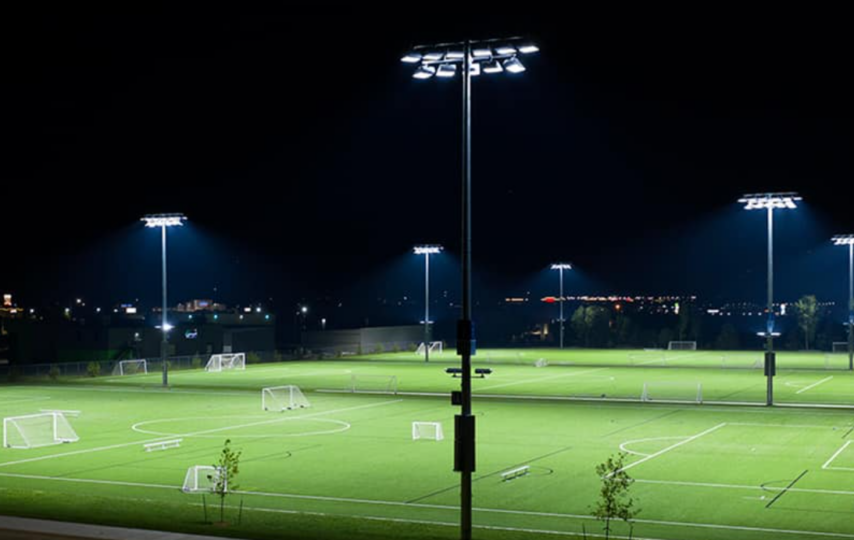A lot of people all over the world love football and play it daily. Good lighting is important for a safe and fun game, no matter if it’s in a professional stadium or a neighborhood field. We will talk about why it’s important to have the right lighting for a football field, the different kinds of lighting systems that are out there, how to choose the right lighting, regulations, and standards, the pros and cons of LED lighting, how to figure out how many lights you need, maintenance and upkeep, case studies of successful installations, and give you some tips and best practices.
Importance of Proper Football Field Lighting
Lighting on a football field is important for more than one reason. It puts the safety of players, officials, and fans first. Good explanation helps players see the ball, their partners, and their opponents better, which lowers the risk of crashes and accidents. Showing the game also helps the refs make the right calls.
Good lighting makes the game better, too. Since fans can see everything going on in the field without any obstructions, the environment is more interesting and fun. Broadcasters can record high-quality images for home watchers when there is enough light.
Types of Football Field Lighting Systems
When it comes to football field lighting, there are several types of systems available.
- Metal halide
Metal halide lights have traditionally been used for sports fields due to their high-lumen output. However, they have a shorter lifespan, require longer warm-up times, and are less energy-efficient compared to LED lights.
- High-pressure sodium lights
High-pressure sodium lights are known for their longevity and efficiency. They provide a warm yellowish glow, but their color rendering capabilities are limited. This can affect the visibility of the game and make it challenging to distinguish between players and the ball.
Factors to Consider When Choosing Football Field Lighting
When selecting the right lighting for a football field, there are several factors to consider.
Level of play and lighting needs are first. Professional stadiums are better lit than community fields. Field size, layout, and atmosphere should also be considered.
Another important issue is energy efficiency. LED lights operate more efficiently than older lighting systems, saving money over time. Lighting maintenance and longevity are also significant. Better than other solutions, LED lights last longer and require less maintenance.
Lighting quality should also be checked. The color rendering index (CRI) measures light color accuracy. A higher CRI lets players see the ball and discern field objects. Lighting should be consistent to minimize dark areas and glare that reduces visibility.
Football Field Lighting Regulations and Standards
Football field lighting rules and standards assure safety and fairness. These standards address glare control, illuminance, and lighting homogeneity. IESNA sets football field lighting standards.
These requirements must be followed to prevent legal concerns and provide proper illumination. Consulting with lighting specialists who are aware of these requirements may assist in guaranteeing the lighting design satisfies the criteria.
Benefits of LED Lighting for Football Fields
LED lighting offers numerous benefits for football fields.
Energy efficiency is a major benefit. LED lights use less energy than conventional lighting, lowering power expenses and carbon emissions. This makes LED football field illumination more sustainable.
LED lights last longer than conventional lighting systems. Repair expenses and downtime are reduced by less frequent replacement and repair. For outdoor sporting grounds, LED lights are more robust and shock- and vibration-resistant.
Players can see the ball and other players well because of the great color rendering of LED lights. The constant light distribution avoids dark areas and shadows, making the playing field well-lit. The fast start-up of LED lights allows for quick lighting without warm-up.
How to Calculate the Number of Lights Needed for a Football Field
Calculating football field illumination requires several factors. Important include field size, planned illuminance, and illumination dispersion. Based on these factors, a lighting professional can recommend the right number of lights.
The level of play and lighting needs determine football field illumination. IESNA recommends illuminance levels for play levels. Avoid dark spots and overexposure with steady lighting.
Illuminance and homogeneity depend on light height, wattage, and beam angle. To ensure field-wide lighting, space lights. Lighting designers may use current tools to create a full lighting plan that includes all these factors.
Maintenance and Upkeep of Football Field Lighting
Football field lights must be maintained to work well and last long. To eliminate dust, grime, and debris, lights must be cleaned regularly. This keeps lighting output and distribution difficulties at bay.
Checking the lights for damage or dysfunction is essential. To avoid game delays, repair broken lights immediately. Routine maintenance should inspect wiring, connections, and control systems for proper operation.
The lighting system should also be updated using new technologies. Upgrades to more contemporary, more efficient LED lights can save energy and increase performance.
Conclusion:
For safety, fun, and the general experience of the game, football fields need to be lit up correctly. LED lighting has become the best option because it uses less energy, lasts longer, shows colors more accurately, and is flexible. You can plan the best lighting for your football field by thinking about things like the field’s size, the rules about lighting, and how to keep it in good shape. Work with lighting experts to make sure you follow all laws and standards and get the most out of the newest lighting technology.








